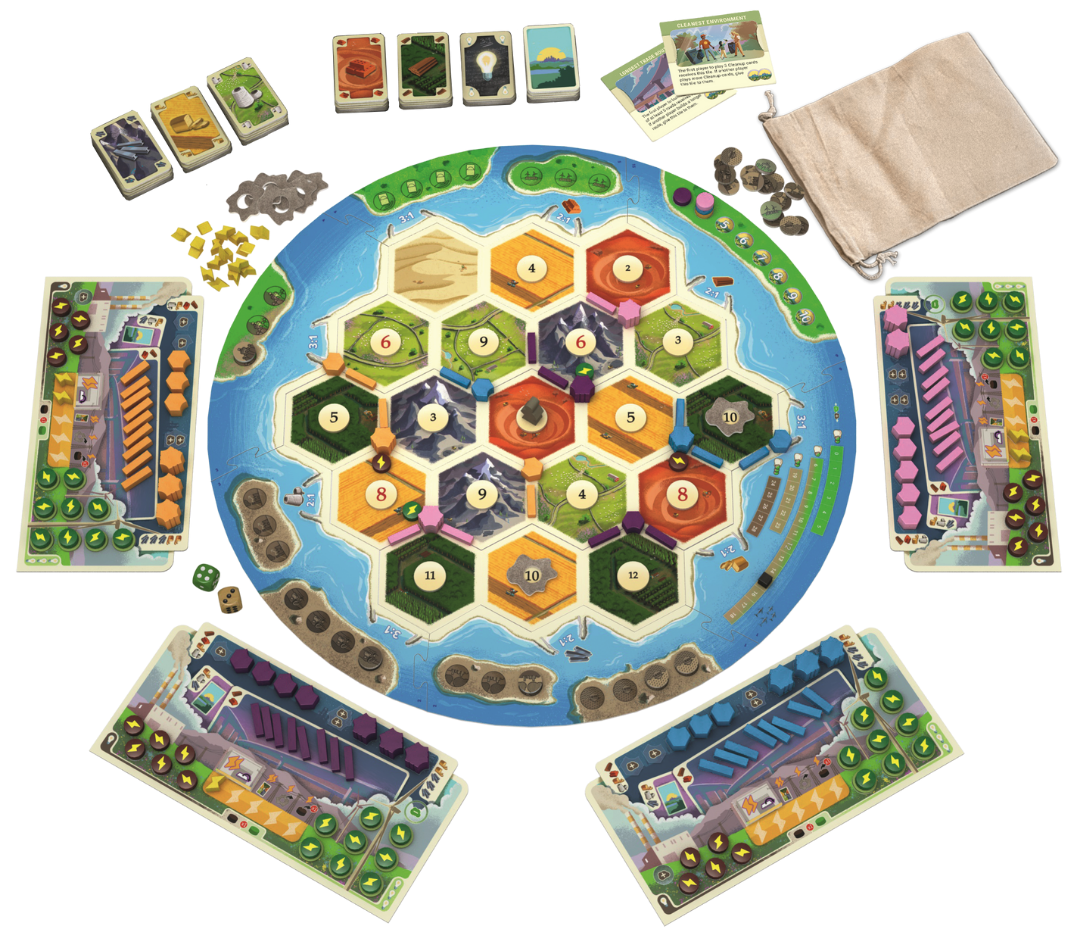Catan is one of the all-time great board games. Simple to learn but difficult to master, there’s a reason why it has inspired tabletop lovers from all over the globe since it was first published in 1995, spawning multiple different versions, expansions, and even a Catan World Championship that takes place every year. It’s a staple for any true board gamer’s collection, its combination of luck and strategy making it endlessly entertaining no matter the skill level. Catan: New Energies is the newest standalone version of Catan available, bringing a sustainability twist to the formula.
While maintaining the core dice-rolling resource-gathering mechanics that have always fuelled Catan, New Energies has you and your fellow players managing energy needs for your societies. There’s an extra layer of chance, as certain events can be triggered throughout the game that provides benefits or negative effects for players, although you could argue that it does slightly over-complicate the simple game of Catan into something else entirely.
The setup for Catan: New Energies is that the agrarian society of the island’s Viking ancestors is long gone, and Catanians need energy to keep society moving and growing; however, pollution is wreaking havoc on the island, and you have to decide where your priorities lie; do you invest in clean energy resources, or opt for cheaper fossil fuels, potentially causing disastrous effects?
The core of what makes Catan so successful remains the same, for the most part, as you’ll need to harvest resources, trade them and then build on hexes to receive additional benefits as the game rolls on. The thrill of the dice roll determining who gets access to certain resources so that you can buy the right cards or build roads is as exciting and frustrating as it ever was, and so New Energies is unlikely to convert anyone who doesn’t enjoy these long-running foundations.
It’s the new gameplay elements of power plants, energy tokens and environmental events that spice things up and create the need for new strategies.
“The addition of power plants, carbon footprints, and semi-cooperative elements makes for a more layered experience…”
Acquiring power plants adds a strategic wrinkle from the jump. You can purchase a fossil fuel plant for one science resource or invest three sciences for a renewable energy plant. While both provide the same energy output, the choice between the two will impact your standing in the game, as fossil fuels increase the carbon footprint and renewable energy helps reduce it. This dynamic creates a satisfying tension between short-term gains and long-term survival.
As you might expect from the title of the game, energy itself plays a larger role. Not only can it help you obtain hard-to-reach resources, but it also influences your fate when it comes to events. See, along with the usual dice roll, you’ll also be pulling a token from a bag at the beginning of each turn. As the game progresses, the carbon footprint becomes more significant; green tokens can lead to positive outcomes, rewarding players who keep their carbon footprint low, while brown tokens can cause negative climate events, which do things like blocking entire cities from producing resources or even causing resource losses.
I’m a fan of random events triggering during board games keeping players on their toes, but what I particularly like about this mechanic in Catan: New Energies is how it affects gameplay for everyone. You’ll need to pursue your own strategy, of course, but the universal carbon footprint impacts everybody at the table, and if too many negative tokens are drawn, the game can end abruptly if you’re not careful. I wouldn’t go as far as to call it cooperative, but it certainly had us collectively gasping as certain tokens got pulled from the bag.
That said, we did find that the green positive events usually benefited the most sustainable player at the time, and as we had one of our group clearly in the lead on that front, they received most of the rewards. For the players in the middle of the pack, they weren’t often impacted by the events at all, which took some of the fun out of it. Still, I enjoyed thinking about other components on the board other than the traditional race to 10 victory points. It makes the game itself a little bit longer than your standard game of Catan, but it was a close race to the finish line that we all enjoyed. Some prefer the simplicity of the OG, while I like this new riff, injecting some much-needed newness to a title that’s been going strong for almost thirty years.

It’s noted on the website that “as in real life, the most sustainable player does not always win, and as in any CATAN game, there are multiple paths to victory,”, and this rings true as well. While this version of Catan is hoping to highlight the importance of investment in renewables, it also comes out at a topical time, where climate change is as important to think about now than it ever has been before.
In an additional neat sustainable twist, the makers have Catan have recognised that producing board games creates an environmental impact. They claim that they have worked hard with their editorial and manufacturing partners to reduce the footprint of Catan: New Energies as much as possible while still providing a high-quality, durable product. It’s assembled in the USA, using sustainably sourced wood and paper, using no plastic pieces.
Catan: New Energies offers a fresh and rewarding challenge, especially for seasoned players. The addition of power plants, carbon footprints, and semi-cooperative elements makes for a more layered experience, and with some sustainable story beats to boot, it makes for a nice addition to the Catan universe overall.
Catan: New Energies is available now in all good board game stores. Thanks to VR Distribution for providing a copy for this review.





